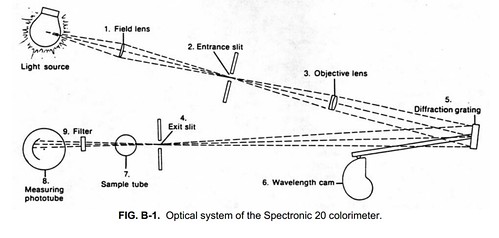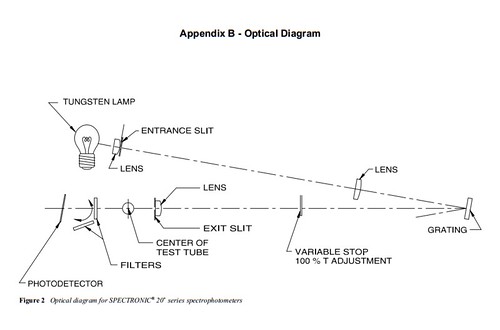I finally opened the Spectronic 20 underside and here's what it looks like! Great to see they jus...
Public Lab is an open community which collaboratively develops accessible, open source, Do-It-Yourself technologies for investigating local environmental health and justice issues.
but of course that's because it's >30 years old and you have to read out the wavelengths one at a time by turning a dial :-)
Classy! On Ebay, you can also see the brand name change as the company was presumably acquired by different parent companies. I believe it eventually became part of ThermoFisher Scientific.
It finally dawned on me that this machine is a monochronomater, attenuater, and photometer. To use it that way all you need to do is to bring out a portion of the beam with a 90/10 mirror and let the 10% hit the photometer. To do this just modfy a cuvette by adding a 90/10 mirror at a 45 degree angle. If you can find some multimode fiberoptic cable and mount it above the mirror and you are in business. Otherwise you can mount the public lab spectrometer above the modified cuvette and "go to town" with the setup.
Wait, you think that it hits the sample with a monochromatic light source? I guess we could easily test that with a mirror, as you describe. That'd be really neat. I just assumed it was diffracting after light passed through the sample, but with their setup, there's no reason they couldn't do it before.
Dan's right that it's a monochromator in that it directs light of one color (a narrow band of wavelengths) through the sample and to the detector. You then write down the intensity of light that hits the detector, and turn the dial to a different color. The dial mechanically turns a cam that rotates the grating so a different color is aimed at the exit slit. The instructions say to use 25 nm increments, which suggests that the resolution is not much better than that.
So I can't spell and the spell check did not help much.
Another thing to do is just appropriately scratch a small area on a fully reflecting mirror so some of the light gets to the meter in order to get a relative intensity value.
I also have an idea on how to effectively couple the light into the fiber if you need to go that route.
Public Lab is open for anyone and will always be free. By signing up you'll join a diverse group of community researchers and tap into a lot of grassroots expertise.
7 Comments
and how much does that thing cost Jeff ?
Is this a question? Click here to post it to the Questions page.
Reply to this comment...
Log in to comment
I see similar models for <$200 on ebay:
http://www.ebay.com/sch/items/?nkw=spectronic+20&sacat=&ex_kw=&mPrRngCbx=1&udlo=&udhi=&sop=12&fpos=&fspt=1&sadis=&LH_CAds=
but of course that's because it's >30 years old and you have to read out the wavelengths one at a time by turning a dial :-)
Classy! On Ebay, you can also see the brand name change as the company was presumably acquired by different parent companies. I believe it eventually became part of ThermoFisher Scientific.
Is this a question? Click here to post it to the Questions page.
Reply to this comment...
Log in to comment
The optical diagram for the Spectronic 20 from here. It has two lenses.
Below, the optical diagram for the Spectronic 20+ from the official manual. It has three lenses.
Reply to this comment...
Log in to comment
It finally dawned on me that this machine is a monochronomater, attenuater, and photometer. To use it that way all you need to do is to bring out a portion of the beam with a 90/10 mirror and let the 10% hit the photometer. To do this just modfy a cuvette by adding a 90/10 mirror at a 45 degree angle. If you can find some multimode fiberoptic cable and mount it above the mirror and you are in business. Otherwise you can mount the public lab spectrometer above the modified cuvette and "go to town" with the setup.
Reply to this comment...
Log in to comment
Wait, you think that it hits the sample with a monochromatic light source? I guess we could easily test that with a mirror, as you describe. That'd be really neat. I just assumed it was diffracting after light passed through the sample, but with their setup, there's no reason they couldn't do it before.
Is this a question? Click here to post it to the Questions page.
Reply to this comment...
Log in to comment
Dan's right that it's a monochromator in that it directs light of one color (a narrow band of wavelengths) through the sample and to the detector. You then write down the intensity of light that hits the detector, and turn the dial to a different color. The dial mechanically turns a cam that rotates the grating so a different color is aimed at the exit slit. The instructions say to use 25 nm increments, which suggests that the resolution is not much better than that.
Reply to this comment...
Log in to comment
So I can't spell and the spell check did not help much.
Another thing to do is just appropriately scratch a small area on a fully reflecting mirror so some of the light gets to the meter in order to get a relative intensity value.
I also have an idea on how to effectively couple the light into the fiber if you need to go that route.
Reply to this comment...
Log in to comment
Login to comment.